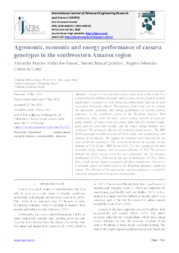Agronomic, economic and energy performance of cassava genotypes in the southwestern Amazon region.
Agronomic, economic and energy performance of cassava genotypes in the southwestern Amazon region.
Author(s): PASSOS, A. M. A. dos; QUINTINO, S. M.; COSTA, R. S. C. da
Summary: Cassava is an important crop in many parts of the world. It is a staple food for millions of people, and it is also used in a variety of other applications. Cassava is a rich source of carbohydrates and can be used to produce fuel-grade ethanol. The purpose of this study was to evaluate the agronomic, economic, and energy performance of several cassava genotypes in the southwest region of the Brazilian Amazon. Root productivity, flour yield, dry mass, starch content, number of roots per plant, number of rotten roots per plant, plant and first branch height, gross and net costs and income, and the crop's energy balance were evaluated. The genotypes affected all evaluated characteristics. The BRS Kiriris genotype excelled in terms of flour yields, root productivity, and absence of rot disease. The highest net revenues were observed for the most productive genotypes. The research disclosed an average energy demand of 9.78 GJ ha-1. BRS Kiriris (252,7 GJ ha-1) produced the most favorable energy balance, with an energy efficiency of 26.9. The greatest demand for direct energy costs for root production was for nitrogen fertilization (37,9%), followed by the use of herbicides (27,9%), which have a high energy charge associated with their manufacture. Cassava is a valuable source of biofuel feed in the Brazilian Amazon's southwest region. The selection of the appropriate cassava genotype is crucial for achieving adequate levels of activity sustainability.
Publication year: 2022
Types of publication: Journal article
Unit: Embrapa Maize & Sorghum
Keywords: Balanço energético, Farinha, Genótipo, Mandioca, Massa seca, Produtividade, Raiz, Rendimento, Teor de amido
Observation
Some of Embrapa's publications are published as ePub files. To read them, use or download one of the following free software options to your computer or mobile device. Android: Google Play Books; IOS: iBooks; Windows and Linux: Calibre.
Access other publications
Access the Agricultural Research Database (BDPA) to consult Embrapa's full library collection and records.
Visit Embrapa Bookstore to purchase books and other publications sold by Embrapa.

